3.16 Tick Infestation – Dogs and Cats
Learning Objectives
- Know the two most common ticks of dogs and cats and the class they belong.
- List the diseases ticks can transmit.
- Learn the form of paralysis that ticks can cause.
- Know the tick that can complete its life cycle on the dog and why it is important to know this.
- Learn how to manage tick infestations.
-
General Considerations:
- Most ticks are not host specific.
- Ticks are divided into argasid (soft ticks) and ixodid (hard ticks).
- The argasid ticks are more primitive and less often parasitic and infest the premises occupied by their hosts.
- Ixodid ticks are more specialized and highly parasitic and infest the open country frequented by their hosts.
- Most clinical problems are due to infestations with ixodid (hard) ticks.
- The most common ixodid ticks that infest dogs and cats are Rhipicephalus sanguineus and Dermacentor variabilis.
-
Cause:
- Argasid (soft) Ticks:
- Otobius megnini.
- Argasid (soft) Ticks:
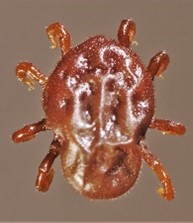
-
- Ixodid (hard) Ticks:
- Rhipicephalus sanguineus (“brown dog tick”, common in dogs and cats).
- Ixodid (hard) Ticks:
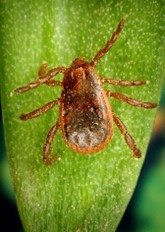
-
-
- Dermacentor variabilis (“American dog tick”, common in dogs and cats).
-
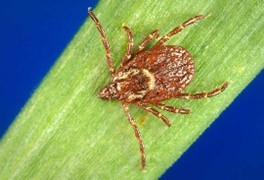
-
-
- Dermacentor andersoni (“Rocky Mountain wood tick”).
-
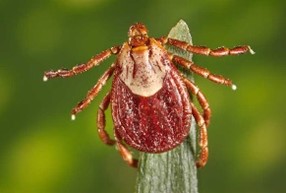
-
-
- Dermacentor occidentalis (“Pacific or West Coast tick”).
- Ixodes scapularis (“Blacklegged tick”).
-
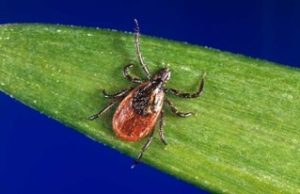
-
-
- Ixodes dammini (“Deer tick”).
- Amblyomma americanum (“Lone Star tick”).
-
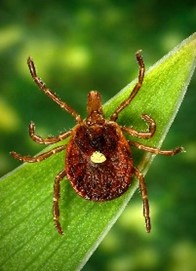
-
- Ticks from both classes pass through four stages: egg, larva, nymph and adult.
- The larva, nymph and adult of both sexes feed on blood and lymph.
- In general, the ixodid ticks necessitate three hosts to complete their life cycle, with the larva and nymph stages primarily feeding on small rodents.
- Although a three-host tick, Rhipicephalus sanguineous can complete its entire life cycle on the dog and can reproduce easily in buildings, presenting special control problems.
- Otobius megnini (spinous ear tick) is the only soft tick of importance in dogs and cats.
- Otobius megnini is a one-host tick but only the larva and nymph stages are parasitic.
- The various ticks can transmit certain diseases or bacterial, rickettsial, protozoal and viral organisms:
- Rhipicephalus sanguineus: babesiosis, anaplasmosis and hepatozoonosis; Ehrlichia canis and Francisella tularensis infection. Rocky Mountain spotted fever. It can cause tick paralysis.
- Dermacentor variabilis: Rocky Mountain spotted fever; St. Louis encephalitis, tularemia, and anaplasmosis. It can cause tick paralysis.
- Amblyomma americanum and Amblyomma maculatum: Ehrlichiosis and hepatozoonosis, respectively.
- Ixodes dammini, Ixodes pacificus, Ixodes ricinus and Ixodes scapularis: Borrelia burgorferi (Lyme disease), ehrlichiosis and anaplasmosis.
-
Clinical Signs:
- Ticks of various life cycle stages may be seen attached to the skin.

-
- Erythema, crusting and a small nodule may develop at the site where a tick was removed.

-
- This is due to an immunologically mediated inflammatory reaction to tick saliva antigens.
- Otitis externa may result from irritation of large numbers of spinous ear ticks in the ear canal.
- Tick paralysis may occur due to a neurotoxin present in the saliva of engorging female ticks of several species of ixodid (hard) ticks, particularly those of Dermacentor spp.
- Tick paralysis appears clinically as an ascending flaccid lower motor neuron paralysis.
-
Diagnosis:
- Observation of ticks during physical or otic examination.
-
Treatment:
- Manual removal by grasping them with either a forceps or gloved finger and applying slow traction until they are pulled free. Commercial tick removers are also available. Soaking the tick with alcohol helps the process.
- For cases of heavy or persisting infestations, the dog may be treated topically with malathion, chlorpyrifos, or pyrethrin, pyrethroid or permethrin sprays or dips.
- Only insecticides registered for cats should be used in cats.
- Collars containing amitraz are available for use in the control of tick infestation in dogs. These collars do not repel or prevent ticks from becoming attached, however, the ticks die and drop off the animal soon after they start feeding.
- Fipronil – Available as a spray (Frontline® Flea spray; Merial) and as a spot-on (Frontline Plus®; Merial) can also be used to treat tick infestation in dogs and cats. The manufacturer claims that ticks are killed within 48 hours after attachment. Apply the product monthly for tick control.
- Selamectin (Revolution® pour-on; Zoetis) – It is an avermectin also effective to manage tick infestation caused by Dermacentor variabilis. It should be applied monthly. However, in heavy infestations one additional dose may be administered 2 weeks after the previous dose.
- Fluralaner (Bravecto™; Merck Animal Health; Summit, NJ) – It is indicated for the treatment and control of tick infestations (Ixodes scapularis, Dermacentor variabilis, and Rhipicephalus sanguineus) for 12 weeks in dogs and puppies 6 months of age and older. It is not effective against Amblyomma americanum ticks beyond 8 weeks after dosing. It is available as a flavored chewable tablet. It is also available as a topical solution to prevent and treat Ixodes scapularis for 12 weeks in cats and kittens 6 months of age and older. In addition, it is indicated for the prevention and treatment of Dermacentor variabilis for 8 weeks. Caution should be used in patients with a history of seizures.
- Afoxolaner (NexGard®; Merial, Inc.; Duluth, GA) – It is available as a once a month, beef-flavored, chewable tablet indicated for the treatment and control of tick infestations (Ixodes scapularis, Dermacentor variabilis, Amblyomma americanum and Rhipicephalus sanguineus) in dogs and puppies 8 weeks of age and older. It may be administered with or without food. Caution should be used in patients with a history of seizures. After 48 hours, NexGard® was >97% to >93% effective for all ticks except Amblyomma americanum. It was >97% effective for Amblyomma americanum after 72 hours.
- Sarolaner (Simparica™; Zoetis) – It is indicated for the treatment and control of tick infestations (Amblyomma americanum, Amblyomma maculatum, Dermacentor variabilis, Ixodes scapularis, and Rhipicephalus sanguineus) for 4 weeks in dogs and puppies 6 months of age and older. It is available as a flavored chewable tablet. Caution should be used in patients with a history of seizures.
- Lotilaner (Credelio™; Elanco US Inc.) It is indicated for the treatment and control of tick infestations (Amblyomma americanum, Dermacentor variabilis, Ixodes scapularis, and Rhipicephalus sanguineus) for 4 weeks in dogs and puppies 8 weeks of age and older. It is also available for the monthly treatment and control of Ixodes scapularis in cats and kittens 6 months of age and older. It is available as a flavored chewable tablet. Caution should be used in patients with a history of seizures.
- Seresto™ flea and tick collars (Bayer HealthCare LLC; Shawnee Mission, KS) are available for both cats and dogs and offer 8 months of prevention and treatment of ticks on dogs and puppies 7 weeks of age and older. It is labeled for cats and kittens 10 weeks of age and older. The collars contain the active ingredients flumethrin and imidacloprid. The manufacturer claims that re-infesting ticks are repelled and/or killed in as quickly as 6 hours and tick infestations are prevented within 48 hours. It is labeled for Ixodes spp., Dermacentor variabilis, Rhipicephalus sanguineus and Amblyomma maculatum.
- Imidacloprid, permethrin and pyriproxyfen (K9 Advantix II®; Bayer HealthCare LLC) – It is available as a once a month spot-on application that repels and kills ticks (Deer ticks, American dog ticks, Brown dog ticks, and Lone Star ticks) for up to 4 weeks. It also repels and kills all stages of fleas and prevents their development. Advantix II® also claims to repel and kill mosquitoes for up to 4 weeks, repel and prevent blood-feeding by biting flies and kill chewing lice. Advantix II® SHOULD NOT BE USED IN CATS. It can be used on puppies and dogs 7 weeks of age and older.
- The premises need to be treated with a product such as chlorpyrifos if Rhipicephalus sanguineus is responsible for the infestation. This is because the entire life cycle of this tick can be completed on the dog, resulting in large numbers of all life stages in the animal’s immediate surroundings.
- In cases of tick paralysis, rapid recovery follows mechanical removal of the entire tick or ticks.
Important Facts
- Dogs and cats are more often infested with Rhipicephalus sanguineus and Dermacentor variabilis.
- Rhipicephalus sanguineus can complete its life cycle on the dog and treatment of the premises is required in cases of infestations with this tick.
- Most ixodid (hard) tick species can cause tick paralysis.
- Ticks can transmit babesiosis, anaplasmosis, hepatozoonosis, ehrlichiosis, Rocky Mountain spotted fever, tularemia, St. Louis encephalitis, and Lyme disease.
- The larva and nymph of the “spinous ear tick” (Otobius megnini – soft tick) can cause acute otitis externa and pain.
- Ticks can be manually removed or treated with insecticidal dips, pour-on solutions, sprays or collars in severe infestations.
- Newer chewable options in the class of isoxazolines exist and there are also tick/flea collars available for cats and dogs.
References
Blagburn BL, Dryden MW. Biology,Treatment, and Control of Flea and Tick Infestations. Vet Clin Small Anim 2009; 39: 1173-1200.
Miller WH, Griffin CE, Campbell KL. Small Animal Dermatology, 7th edn. St. Louis, MO: Elsevier, 2013; 294-296.
Saleh MN , Allen KE, Lineberry MW, et al. Ticks infesting dogs and cats in North America: Biology, geographic distribution, and pathogen transmission. Vet Parasitol 2021; doi.org/10.1016/j.vetpar.2021.109392.
Scott DW, Miller WH, Griffin CE. Small Animal Dermatology. 5th edn. Philadelphia: W.B. Saunders Co., 1995; 417-432.
Starkey LA, Little SE. Canine tick-borne diseases. Todays Vet Prac 2015; July/August:55-60.
Vatta AF, Young DR, Everett WR. Efficacy of a new topical formulation containing selamectin plus sarolaner against three common tick species infesting cats in the United States. Vet Parasitol 2018; doi.org/10.1016/j.vetpar.2018.10.013.
Zhou X, Hohman AE, Hsu WH. Current review of isoxazoline ectoparasiticides used inveterinary medicine. J Vet Pharmacol Therap 2022; 45: 1-15.

